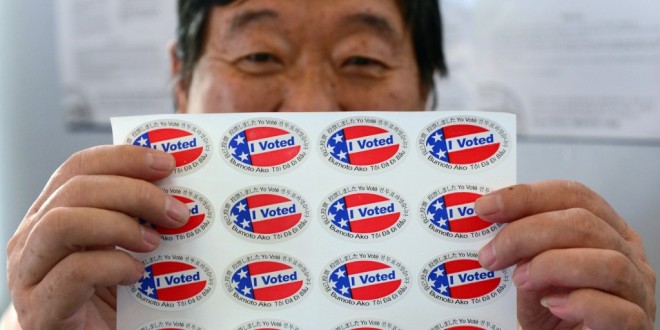By Jennie L. Ilustre
What do swing states California, Nevada, Florida, Arizona, North Carolina and Georgia have in common? Answer: They all have a growing number of Asian American and Pacific Islander (AAPI) voters.
AAPI voters make up 4% of the nation’s electorate. But as the fastest-growing ethnic group, AAPIs have also grown as a voting population in states that could determine who wins in national and local elections.
As AAPI Data Director Karthick Ramakrishna noted when AAPI Data and APIAVote jointly released The 2018 State Fact Sheets: “In every state across the country, fast-growing Asian American and Pacific Islander communities continue to increase our electoral strength, including in battleground states such as Nevada, Virginia, and Florida.”
Recently, APIAVote and AAPI Data jointly released the data which provide “a snapshot profile of Asian Americans and Pacific Islanders (AAPI) and forecast their rising electoral power.” The Fact Sheets showed the population growth rate of Asian Americans and Pacific Islanders In nearly every state climbed within a six-year period. Notably, between 2010 and 2016, AAPIs grew into a larger share of the electorate. This was demonstrated in their record turnout in the 2012 and 2016 presidential elections.
Remarked APIAVote Executive Director Christine Chen: “The fact sheets provide a roadmap to unlocking AAPI political power in these states. They highlight the obvious potential for increased voter registration, engagement and turnout. That’s why APIAVote and our partners are focused on adding new voters to the rolls and turning infrequent voters into regular voters.”
Political Clout
For years, the Mainstream Media have been noticing the growing political clout of Asian Americans at the ballot box. The 2018 State Fact Sheets and new developments, such as the minority group’s voting shifts, have once again gained their attention. The political experts re-emphasized the untapped potentials of the nation’s fastest-growing ethnic group. Nearly half of Asian Americans do not consider themselves aligned with either party, making their vote up for grabs.
On May 15, Chris Fuchs stressed in the NBC News website that although Asian American registered voters have shifted left (that is, voted Democrat), nearly 2 in 5 do not identify as either a Democrat or Republican. His analysis was titled, “Nearly 40 percent of Asian-American voters don’t favor a party. Can the DNC change that?” He was referring to the Democratic National Committee.
New York Times Columnist David Leonhardt wrote an opinion piece, “Asian-Americans, a Sleeping Political Giant,” published on April 5. He cited Virginia as an example of a state that has shifted to the left after decades of being a Republican stronghold, voting Democratic since 2010 in races for president, senator and governor.
In Virginia’s transformation, he added, “one major cause of it hasn’t received much attention: Asian-American voters.” He pointed out the minority group’s population boom, as well as its increase in voter turnout.
Leonhardt cited Saahil Desai’s article in The Washington Monthly, noting that as Republicans have become more radical on racial and cultural issues, Asian Americans have become even more Democratic. But Desai also warned that Democrats shouldn’t take the loyalty of Asian Americans for granted, adding that on some issues like affirmative action, Republicans have an opening. The Republican Party had previously won their vote, Desai said. During the 2014 midterm elections, Republicans garnered 50 percent of the Asian American and Pacific Islanders vote.
NBC News’ Fuchs pointed out that Democrats need to win 24 seats to gain control of the House of Representatives. Democrats need to gain two seats, aside from retaining their current numbers, in order to retake the Senate. The media and political experts have been writing about a “blue wave” or a Democratic sweep, as well as a “red wave” (Republicans prevailing) in the midterm elections – but November 6 is a long way, and so many things can still happen, in the blink of an eye, too. Both the Democrats and the Republicans have expressed optimism and pessimism, depending on the news cycle.
Battleground States
The APIAVote and AAPI Data 2018 State Fact Sheets detailed data on Asian American and Pacific Islanders, which are provided by the U.S. Census Bureau’s ACS 5-year Estimates. The information and statistics that follow only include the battleground states of Virginia and Nevada. The 2018 State Fact Sheets list states alphabetically at www.apiavote.org
VIRGINIA
ELIGIBLE AAPI VOTERS: 338,415
AAPI SHARE OF ELECTORATE IN THE STATE: 5.3%
Nearly a third (32%) of eligible AAPI voters in Virginia lives in Farifax County, where AAPIs make up 15% of the electorate.
TOTAL AAPI POPULATION: 660,795
Largest AAPI groups
Indian Americans: 152,343
Filipino Americans: 108,947
Chinese Americans: 91,663
Korean Americans: 88,345
Vietnamese Americans: 68,949
Pakistani American: 33,669
NEVADA
ELIGIBLE AAPI VOTERS: 202,091
AAPI SHARE OF ELECTORATE IN THE STATE: 10%
More than half of all eligible AAPI voters (61%) in Nevada live in Clark County, which includes Las Vegas. The counties with highest AAPI populations are Clark: 122,640; Washoe: 15,645 and Carson City: 1,125. From 2010 to 2016, the number of eligible AAPI voters in Nevada grew 35%.
AAPI POPULATION SIZE:
AAPI POPULATION GROWTH RATE SINCE 2000: 167%
The largest AAPI groups in Nevada include: Filipino Americans (162,936), Chinese Americans (50,878), JapaneseAmericans (26,359), Korean Americans (16,169), Vietnamese Americans (16,169), and Indian Americans (15,022).
 Asian Fortune Your source for all things Asian American
Asian Fortune Your source for all things Asian American





